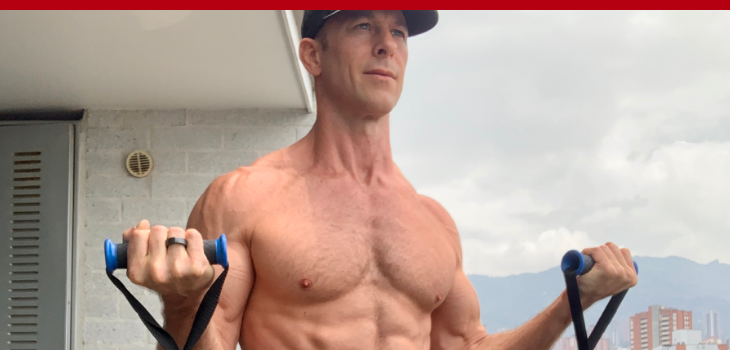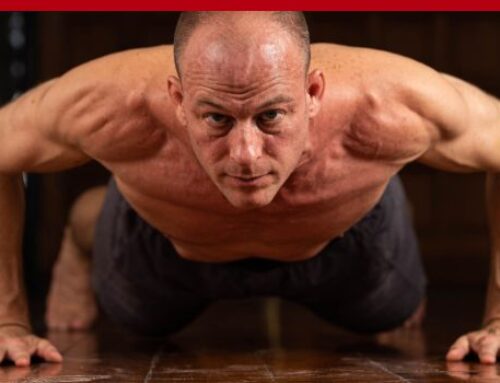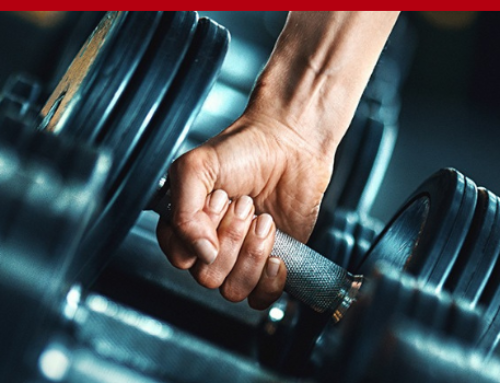
The Ultimate Guide To Stay In Shape Without Leaving The House with Ted Ryce
Maybe you’re practicing self-quarantine. Maybe you work from your apartment and are avoiding the gym. Either way, this is a time that wellness matters the most. That’s why I put together a practical guide to help you stay fit at home. Plus, three easy and effective at-home workouts that you can start following right now. Listen now!
If you’re interested in learning how to get into great shape without going to the gym, then this article is for you.
With Coronavirus (and Covid-19) craziness spreading across the world right now, more and more people are being advised (or even ordered) to stay in their homes.
As a digital nomad who’s traveled all over the world, I’ve mastered getting (and staying) in shape without all the equipment that you’d have in a typical gym.

I see a lot of workouts being shared right now…
- Circuit training where you do an exercise for a specified period of time
- Workouts where you’re supposed to hit a predetermined number of reps for an exercise (i.e. perform 50 bodyweight squats)
- And other well-meaning but less-than-optimal advice
The problem with these approaches is that while they’re better than sitting on the couch, they’re not going to deliver results.
And if I’m going to spend my valuable time doing exercise, I want the best return on my investment of time and energy.
That’s why I’ve created this practical guide for people who want to see a serious results from their workouts every single week—even if they can’t eave their house and don’ have access to much exercise equipment.
We’ve had incredible success with no-gym workouts for our Online Coaching Program, allowing our clients to train from their homes, hotel rooms, or self-isolated in quarantine.
For example, when 57 year-old Tim signed up to our coaching program, he specifically stated that he wanted to workout at home. So I designed a program that I knew would help him build lean muscle while losing fat at the same time while only using bodyweight exercises he could do at home.
Check out his results:

Pretty impressive, right?
He lost all that fat and built muscle while working out with bodyweight workouts that he did from home.
And you can too.
You don’t need a ton of equipment…or any equipment really.
But you DO need to understand the principles that build muscle—regardless if you’re using a barbell, dumbbells, or just your body.
Here’s what we’ll cover in our guide, How to Stay in Shape Without Leaving the House:
- 4-Step System To Create A Leaner, Stronger, And Healthier Body While Stuck At Home
- 5 Rules To Maximize Muscle Growth And Fat Loss With Home Workouts
- 3 Simple & Effective Workouts You Can Do At Home
- Other Secrets To Get Fit At Home
How to Stay in Shape While Staying Inside

Most gyms are closed and we’re all stuck inside while the coronavirus quarantines get enforced all over the world.
Here’s the best advice I can give you: this is our new normal for the foreseeable future so learn to adapt and overcome!
The first rule is that nutrition is still going to be the #1 priority if losing fat and staying lean is your goal.
That means the most important thing you can do to stay in shape is to focus on your nutrition.
Why?
Well, let’s first take a look at your metabolism and the factors that influence it:

As you can see from the above infographic, your metabolism is made up of two things:
- The energy coming in
- The energy being burned
The factors that influence the energy coming in are:
- Food. The meals you eat is a big part of the energy
- Drinks. The calorie-containing beverages you drink can be a big part of the energy you take in every day—especially if you’re drinking things like 500 calorie frappuccino’s.
- Snacks. Many people don’t realize that the little handful of candies or chips you have throughout the day can add a significant amount of energy coming into your body.
- Alcohol. The beer, wine, liquor and cocktails you drink all add to the energy coming into your body.
The factors that influence the energy going out are:
- Basal metabolic rate (BMR). This is how much energy your body uses to perform its vital functions like keeping your heart beating, breathing, etc.
- Exercise. This is purposeful exercise like resistance training, cardio, and playing sports.
- Activity. This is known as non-exercise activity thermogenesis (NEAT) in the science world. It’s the activity you do like the steps you take every day, your muscles that maintain your posture, me typing furiously to finish this article, etc.
- Thermic effect of food (TEF). This is how much energy that your body uses to digest food. Whole foods, high-protein and high-fiber foods take a lot more energy than processed foods or low fiber and low protein foods.
After reading this, you might be tempted to say, “Hey, I can just exercise more and increase my steps to lose fat and stay lean without changing my nutrition!”
Maybe.
But consider this…
One slice of Kirkland frozen cheese is 280 calories. And 30 minutes of running will burn between 280 and 520 calories, depending on your weight and speed.

Here’s a telling story from our community: one of our coaching clients, Jeff, was training Crossfit and doing other workouts regularly.
He only started seeing results when his coach helped him switch up his diet.

That’s why we focus on nutrition so heavily in our online coaching programs.
When you stock up your kitchen, pantry, or underground bunker with food, make sure the choices match with your fitness goals.
Here’s my 4-step system to create a lean, strong, and muscular body even when you’re super busy, or stuck at home, or even facing a pandemic situation.

Step #1: Track Your Nutrition.
The best way to get a handle on your nutrition is the same as if you wanted to get a handle on your finances—you track it! Tracking helps you develop awareness of how much you’re eating and which foods you eat. You can use an app like MyFitnessPal or kick it old school ad write it down.
Step #2: Prioritize Protein.
As you learned from the metabolism infographic above, certain foods take more energy to digest than others. Protein has a much higher thermic effect of food (TEF) than carbs or fat. Protein also helps you build and/or maintain muscle mass.
Step #3: Learn About Portion Sizes Of Different Foods.
If your quarantine meals are composed of rice, pasta, oatmeal, cereal, and family-sized containers of peanut butter from Costco, then it’s crucial that you understand the correct portion sizes. It’s easy to overeat these foods.
Step #4: Strive For Progress Not Perfection.
One of the issues that comes up for my coaching clients is they feel the need to be perfect. But the reality is that perfection doesn’t exist. And you might be stuck for weeks or longer eating less-than-optimal meals. So put aside perfection with your food choices and focus on your calorie intake to keep your weight and body fat in check.
If you follow these 4 steps, you’ll start to see results in the first week. And in case you want to learn more about each step, please check out the resource below.
Here is my #1 resource to help you focus on nutrition while you’re stuck inside. Watch our current free on-demand training workshop on the exact process and method we are using to help our clients to lose 20-30lbs in 12 weeks and keep it off for good. We’ve done one for men and one for women.
5 Rules To Maximize Muscle Growth And Fat Loss While Working Out At Home

I see a lot of home workouts circulating right now…
Circuit workouts where you perform a series of exercises for a specified amount of time. (Ex: sit-ups for 45 seconds, squats for 45 seconds, etc.)
Workouts with an arbitrary number of reps to complete for each exercise (Ex: 50 push ups, 100 squats, etc.).
Crossfit-style WODS with a bunch of different exercises. (Ex: run 1 mile, 50 pull-ups, 100 push-ups, 200 squats, etc.)
While doing these might be better than sitting on the couch, performing randomly put together workouts isn’t going to give you the best return on your investment of time and energy.
So what will?
Easy.
Focus on proven scientific principles for building muscle.
Let’s jump into those now.
Rule #1: Take each set to muscular exhaustion.
The first thing you need to make happen when you do a strength training exercise is to work your muscles to exhaustion on whatever exercise you’re doing. Although the explanation for this quite complex, the short version is that his activates the muscle fibers to the fullest extent.
While it’s somewhat controversial, there’s an idea that the reps at the end of a hard set are the ones that contribute the most to growing muscle. This concept is called “stimulating reps.” Stimulating reps only happen at the end of a set when you’re getting close to muscular failure.

As you can see from the photo above, the rep maximum is on the vertical axis and the number of stimulating reps is on the horizontal axis.
The big take-away here is that you need to take each set close to failure if you want to see big change in your body.
By the way, t here’s no need to actually go to complete failure. Just make sure you work hard on every set you perform. That’s why pre-prescribed reps (do 50 squats) or timed intervals for exercise (perform squats for 45-seconds) aren’t as effective as simply taking a set to muscular exhaustion.
Rule #2: Do more than what you did last time.
This is known as the “Principle of Progressive Overload” in exercise science. A simpler way to put it is you have to continue to challenge your muscles if you want them to grow.
The formal definition of Progressive overload is the gradual increase of stress placed upon the body during exercise training. A medical doctor named Thomas Delorme developed this concept while rehabilitating soldiers after World War II.
When done properly, your strength and fitness levels should increase like this:

That means every time you show up to the gym, you should be trying to hit a personal best. It won’t happen every single workout. But I coach my clients on shooting for doing more I every single workout—even if they aren’t able to improve every time.
There are 3 ways to increase the challenge in a way that leads to more muscle:

- Increase the reps. This is the first goal I coach my clients on. Stick with the same weight for at least two workouts and focus on performing more reps with the same weight.
- Increase the weight. If you’ve used the same weight for at least two workouts and you were able to perform more reps every time, then it’s time to add more weight. How much should you increase the weight? In general, I recommend adding as little weight as possible. That way you’ll avoid hitting plateaus.
- Add another set. After going up in reps and adding weight, it might be time to increase the number of sets you’re doing per a muscle group. I save this one for last because adding more sets puts a greater demand on your recovery than increasing reps and adding weight. I’ve also found that adding sets makes it harder to tell whether someone is actually progressing or not. So be intentional when you add sets so that you’re not adding more volume just because you think more is better.
Rule #3: Focus on recovery.
After speaking about progressive overload, it’s important to talk about recovery. You might be thinking that more reps, weight, and sets you add, the better. But that’s only half true.
The other half of the equation is hat you need to make sure you’re actually recovering in between workouts. Otherwise, you’re just driving yourself into the ground with exercise while not actually making any worthwhile improvement.
For example, take a look at the graph below.

As you can see, if you don’t push yourself enough, you won’t make much improvement from session to session. In fact, your progress might be so little that you don’t even notice it. You may not even be able to perform an additional rep.
On the other hand, if you don’t properly recover from your workouts, you can even lose performance from session to session. When you get this right, you’ll experience steady progress over time.
If you’re not consistently getting stronger (improving reps or adding weight) and/or you’re generally feeling more fatigued, you should reduce back off the number of sets or workouts per week until you feel better and your numbers start going back up.
Things that can sap your workout progress include:
- Sleep deprivation
- Poor stress management
- Calorie deficits or unintentional under eating
So what is the best way to make sure we’re not spinning our wheels with our workouts or driving ourselves into a result-crushing fatigue hole?
That’s what we’re going to tackle next.
Rule #4: Track your workouts to ensure progress.
“What gets measured gets managed.” This is famous quote by the legendary management guru Peter Drucker.
This concept is true whether we’re trying to balance our checkbooks, stop a pandemic, or simply make sure our workout routine is working.
In our online coaching programs, all of our clients track their workouts so that we can guarantee they’re getting the results they signed up for.
Here’s a screenshot from our app that demonstrates our client Wayne’s progress in the seated dumbbell shoulder press:

As you can see, he’s practicing exactly what I’m teaching you here. He uses the same weight for at least two workouts. Then he increases the weight to continue to challenge his muscles. That’s the type of progress you should be aiming for. And we have data on this for every exercise in his workout.
While we use workout tracking in our app, you ca simply write it down with pen and paper or use your note app in your Smartphone. Whatever you do, just make sure you’re tracking your workouts if you’re serious about achieving the best results in the shortest amount of time.
Rule #5: Be Consistent.
I’m sure you’ve heard that consistency is king when it comes to getting results from your workouts. Another quote that comes to mind is, “Just showing up is half the battle.”
What you may not have heard is the exercise principle called the repeated bout effect.
If you have ever taken a few weeks off from exercise and then showed up to the gym and completed a hard workout, then you’ve experienced the repeated bout effect in action.
You know that after that hard workout, you’re going to be sore. But you also know that if you keep showing up, the soreness gets less and less every time until it completely goes away.
That’s because when you perform a new workout your body will experience a new stimulus that stresses your muscles. But as you keep showing up, the level of stimulation from the same workout becomes less. That’s why the principle of progressive overload (Rule #2 from above) is so important.
But for this to happen, you need to keep showing up week after week, month after month, year after year.
On the other hand, there’s another exercise science principle called “detraining.” In simpler terms, it means that you lose it if you don’t use it.
In just two weeks you start to lose fitness if you stop completely. But there’s a silver lining here.
It doesn’t take much to keep what you’ve got. That’s why I’ve ranted so extensively about the “all or nothing” mindset. Just one set of several resistance training exercises per week is the difference between keeping what you’ve got (and maybe even making some slight improvement if you follow the steps I’ve outlined here) and going backwards. As Nike says, “Just do it.”
3 Powerful Workouts You Can Do At Home

Keep in mind that one of the biggest challenges you’ll face as you switch to home workouts is to stay consistent with them.
Personally, I love working out home (actually AirBnBs but whatever haha) because I can take my time with my workout, jot down ideas as they come up, and I love saving he time I’d take to travel. These days, the only gym I’m motivated to go to are Brazilian jiu-jitsu or Muay Thai gyms.
That said, many of my clients who are used to he energy and social aspects of the gym find it hard to get motivated to workout at home.
So here’s what I recommend:
- Make a commitment to yourself
- Schedule your workouts into your calendar and stick to your schedule
- Follow a specific routine so you aren’t left wondering what exercise you should do next.
Here are 3 workout routines you can do at home:
At-Home Workout#1: Beginner Bodyweight Workout
- Reverse Lunges 3 x 10-30 reps
- Push Ups 3 x 10-30 reps
- Towel Rows 3 x 10-30 reps
- Squats 3 x 10-30 reps
- Front Plank 3 x 10-30 reps
- Towel Lat Pulldowns 3 x 10-30
At-Home Workout #2: Intermediate Bodyweight Workout
- Bulgarian Split Squats 3 x 10-30
- Pike Push Ups 3 x 10-30
- Towel Rows 3 x 10-30
- Squats 3 x 10-30
- Feet-Elevated Push-Ups 3 x 10-30
- Towel Lat Pulldowns 3 x 10-30
At-Home Workout #3: Band Workout
- Bulgarian Split Squats 3 x 10-30
- Band Push Up 3 x 10-30
- Band Row 3 x 10-30
- Squats 3 x 10-30
- Band Arnold Press 3 x 10-30
- Band Straight Arm Pulldowns 3 x 10-30
There you have it.
Follow one of the above programs while applying the rules we went over earlier and you’re going to see results—even if you’re used to lifting heavy weights in the gym.
If you want a more customized approach for your exact situation (special equipment, an old injury, kids), then check out Legendary Life Coaching.
Other Secrets For Getting Fit at Home

Secret#1: Get Up & Move More
You may think that just being more active doesn’t really burn much energy compared to a workout. And you’d be wrong.
Believe me, I used to think the same way. Until the science was so strong, I couldn’t live in denial any longer.
A study published in European Journal of Clinical Nutrition found that the energy expenditure difference between sitting in a chair all day long and getting up and moving was 300 calories per day. That’s similar to what a person would burn in 30 minutes of running.
The researchers also found that the difference between sitting at a desk all day and having a standing workstation was 700 calories. Maybe it’s time to invest in that standing or treadmill desk!
Secret #2: Perform Mobility Exercises Throughout The Day
This is one of my secrets. You may have heard of mobility exercises before, but I do them very differently than everyone else. I use isometric holds and bands for resistance with many of them.
I’ll share with you some of my best mobility exercises here so you can try them out. You can choose to them in several ways:
- Choose an exercise or two and do them 1-3 times per day.
- Choose several exercises and put hem into a circuit to perform 1-3 times per day.
Here is a favorite 5-exercise mobility circuit I give to my coaching clients:
- Do 1 rep for each side
- Hold each rep for 30-seconds
- Do 5-10 reps on each side
- Perform a 10-second isometric hold on each rep
- Use a miniband for resistance if you have it
- Do 5-10 reps on each side
- Perform a 10-second isometric hold on each rep
- Do 5-10 reps on each side
- Perform a 10-second isometric hold on each rep
- Use a miniband for resistance if you have it
- Do 5-10 reps
- Perform a 10-second isometric hold on each rep
Secret #3: Track Your Steps
What’s really cool is that with all the wearables on the market, it’s so easy to track your steps so that you can stay on top of your daily movement.
Another cool thing (or a little creepy depending on how you look at it lol) is that with Smartphone in your pocket, you now know how many steps you’re taking every single day without even investing in a fitbit or jawbone. Of course, if you’re a person who leaves their phone on their desk during the day, you’re not going to get an accurate count but it’s better than no data at all.
Personally, I track my daily activity with my Oura ring. Since the only time I don’t wear it is when I’m charging it, I get a very accurate idea of how much I’m moving. Oura also sends me reminders if I’m not moving enough. And no, I don’t have any affiliate relationship with them. Just a huge fan of their product. I recommend that all my clients invest in one.
Whatever method you choose, make sure you stay on top of your daily movement while you’re stuck at home.
A personal favorite of mine is to pace or talk a walk while I’m on phone calls. While you may not be able to get your heart rate up that high o be considered training, you can still walk quite briskly and rack up the steps.
If you spend a good deal of time on phone calls at your desk, it makes sense to invest in a treadmill desk
Secret #4: Cardio With Kids
One of my clients was telling me about how he was struggling to get his cardio in on his Peloton bike because he needed to spend time with his kids. His wife was watching them while he worked. And afterward, she expected him to take over.
So we came up with the idea that he’d get his cardio in with his kids. Here’s how it works.
You set a timer for a specific amount of time. Say 30-60 minutes. Then your goal is to get your heart rate up and keep it up while physically playing with your kids. Running, wrestling, biking, walking, rough housing (my favorite haha). It’s all fair game as long as you keep your heart rate up.
Not only is he getting his cardio in, he’s leading by example and showing his children that exercise is a fun thing that you do with your family. How cool is that?
Secret #5: Dance Party At Home
Drastic times mean taking drastic measures. Turn on some good beats and let your body move to the music.
Have kids? Awesome.
Turn on something they can enjoy too (like that baby shark song) and get them moving too.
Set a timer or dance for at least 5 or 6 and keep moving.
Bottom Line

We are dealing with something unprecedented; but that also means we have a HISTORIC opportunity to lead and grow. Fitness facilities have been closed and if you’re like the majority of people in the world, you’ve been forced to join the legions of work from home employees against your will. Or maybe you own your business and you’re working at home trying to find strategies to survive and thrive.
Here’s the deal, whatever camp you fit in, I know it can feel hard to get up and moving in the same space you’ve been lolling on your laptop in your favorite pair of sweats.
But, the truth is that you have two choices right now.
You can go and start following these at-home workouts, applying my 5-step rule, and other fat loss secrets that I shared with you in this article and make the Coronavirus crisis an opportunity to be a role model for your family, stay in shape, and practice healthy habits that your future self will thank you.
Or you can be the person who pops 20 bottles of wine, stop seeking your goals, complain, watch every episode of every show ever, dive deeper into distraction, wade into the pool of pessimism, and check out from your day, your goals, your family, your team, and your purpose.
The CHOICE is YOURS.





